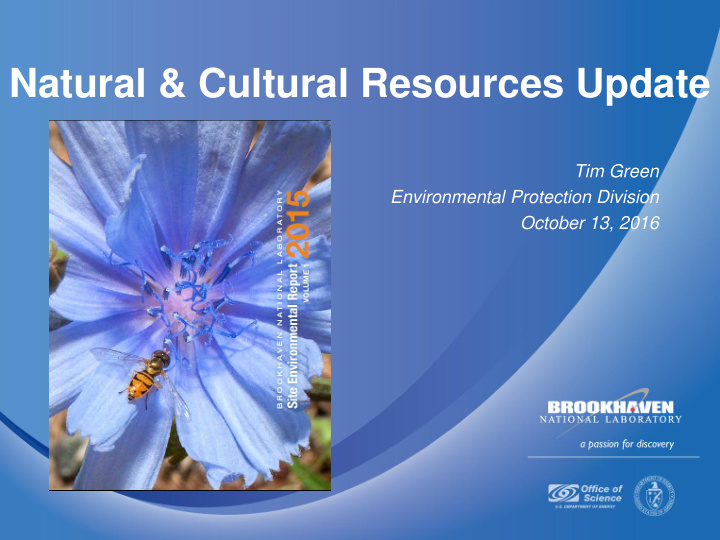



Natural & Cultural Resources Update Tim Green Environmental Protection Division October 13, 2016
Agenda 2015 SER Chapter 6 Natural Resource Update Cultural Resource Update
Chapter 6 - Natural and Cultural Resources Natural Resource Management – Deer Management – removal of 300 deer, end of year population of ~500 – Northern long-eared bat federally listed as threatened – Continued opportunities for interns looking at a variety of ecological topics Surveillance Monitoring – Cs-137 in deer had similar results as Figure 6-2. Comparison of Cs-137 Average Concentrations in Deer Meat (2015) past years - highest value 1.92 pCi/g, wet weight, on-site central lab. – Ten year trend shows decline; 2015 on- site average in meat was 0.29 pCi/g, wet weight, with ten year on-site average being 1.0 pCi/g, wet weight. – Composite samples (5 deer/sample) from deer cull resulted in 60 samples. Highest value 0.89 pCi/g, wet weight, with average of 0.26 pCi/g, wet weight. Figure 6-3. Ten-Year Trend of Cs-137 Concentrations in Deer Meat
Chapter 6 - Flora and Fauna Monitoring (continued) Fish Monitoring – Post Cleanup - Radiological monitoring - on- and off-site fish sampling indicated low levels of Cs- 137 (<0.25 pCi/g, wet weight) - Non-detect values for Carmans River location - consistent with previous years; - Mercury monitoring - max value 3.26 mg/kg in a largemouth bass from on site Area C - max value 0.61 mg/kg in a largemouth bass from Donahue’s pond - max value 0.19 mg/kg in a largemouth bass from Carmans River location
Chapter 6 - Flora and Fauna Monitoring (continued) Peconic River and Lower Lake, Carmans River Mercury Distribution in Fish Species (Minimum, Maximum, and Average Values). Red line is 0.3 mg/kg water criterion.
Chapter 6 - Flora and Fauna Monitoring (continued) Peconic River – Post Cleanup Monitoring – Mercury in sediment - highest value of 23.0 mg/kg from PR-WC-06. – Area of elevated mercury delineated (146 samples). – Plan developed to cleanup area containing elevated mercury – River mostly dry due to removal of STP discharge. Extent of Mercury contamination at PR-WC-06
Chapter 6 - Flora and Fauna Monitoring (continued) Peconic River – Post Cleanup Monitoring – River mostly dry due to removal of STP discharge. Table 6-9. Post Cleanup Peconic River Water Column Monitoring (2015). June 2015 July 2015 Mercury Methyl Mercury TSS Mercury Methyl Mercury TSS Dist from Locatoin Station Description STP (miles) ----------- ng/L ----------- mg/L ----------- ng/L ----------- mg/L PR-WC-15 Upstream of Forest Path -0.17 SW SW SW SW SW SW PR-WC-14 Upstream of STP -0.13 SW SW SW SW SW SW PR-WC-13 Upstream of STP -0.07 SW SW SW SW SW SW PR-WC-12-D7 Downstream of Sump -0.04 10 2.7 < MDL 3.4 1.4 < MDL STP-EFF-UVG Grab Sample 0 No Discharge in 2015 PR-WC-11DS "50"" downstream of outfall" 0.01 SW SW SW SW SW SW PR-WC-10 West of HMN 0.3 SW SW SW SW SW SW PR-WC-09 Downstream of HMN 0.56 SW SW SW SW SW SW PR-WC-08 South of Area B 0.78 21 1.6 < MDL SW SW SW PR-WC-07 South of Area C 0.96 SW SW SW SW SW SW PR-WC-06 South of Area D 1.1 SW SW SW 4.7 0.48 8 PR-WC-05 Downstream of HQ 1.46 SW SW SW SW SW SW PR-WC-04 2nd downstream of HQ 1.7 SW SW SW SW SW SW PR-WC-03 3rd west of Schultz Rd. 2.1 20 1.3 4 26 1.2 7 PR-WC-02 2nd west of Schultz Rd. 2.52 SW SW SW SW SW SW Notes: See Figure 6-5 for Peconic River water sampling locations. MDL= Method Detection Level SW = water too shallow to sample or location was dry
Chapter 6 - Flora and Fauna Monitoring (continued) Other surveillance monitoring – Terrestrial grassy vegetation and soils; – similar to past years. – non-detect to 0.43 pCi/g, Cs-137 in vegetation – 0.05 to 2.84 pCi/g, Cs-137 in soil – High values for both vegetation and soils from same location – Precipitation monitoring – – radiological data similar to past years; – mercury - highest 2015 value 18.2 ng/L. – Compared to highest historic value of 24.6 ng/L recorded in 2013
Chapter 6 - Cultural Resource Management Cultural Resource Activities 2015 Cultural resource tagging project implemented NY SHPO concurrence on Section 106 reviews for demolition of four early BNL support buildings History of BNL Site presented to Summer Sunday visitors and other organizations Tennis for Two (first video game) materials loaned to museums for displays on the history of video games
Natural Resource Update Deer Management Effects of 2015 cull still evident (300 deer removed) Few deer seen around buildings Supports concept of limited deer movement Planning in process for FY2017 cull Population currently estimated at 500+ (surveys in process) Target population <250 4-Poster Continue drop in tick numbers Evaluating summer 2016 data Drought – helping? Fewer deer helping
Natural Resource Update (cont.) Pollinators 2014 Presidential Memorandum Pollinator Health Task Force Departmental Commitment Identified BNL and other DOE facilities Adopted Best Management Practices Committed to developing metrics BNL Actions (to date) Establish no-mow areas Established research Genetic finger printing Acoustic monitoring Bee tongue-flower relationships Planted native grasses and flowering plants 10 acres at STP - 2015 12 acres within no-mow areas - 2016
2016 Seeding – pollinator plants
Cultural Resources - update Tagging Project Over 170 Items Additional items being added as identified and resources allow NSLS Items Cyclotron items Met Tower Beacon
Recommend
More recommend